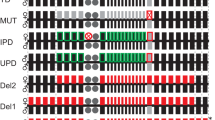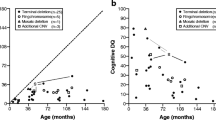Abstract
The case of a 15-year-old male with Angelman syndrome, paternal uniparental disomy of chromosome 15, and a small supernumerary marker chromosome is discussed. Assessment of cognitive functioning revealed an uneven profile of ability across different domains; in particular, receptive language ability was found to be superior to expressive language ability, whilst both gross and fine motor skills were found to be relatively well developed. Assessment using the Autism Diagnostic Observation Schedule showed very little evidence of autistic symptomatology. The patient showed an interest in social interaction and used a variety of methods to communicate, including some gestures and several single words. A clinical history revealed febrile convulsions during childhood but an absence of seizures in the previous 5 years. The patient was not hypopigmented, and height, weight, and head circumference were within the normal range for his age. The implications of these features are discussed in the context of previous work describing a milder phenotype in nondeletion cases of Angelman syndrome and work that has examined the prevalence of autism spectrum disorders amongst individuals with Angelman syndrome.
Similar content being viewed by others
REFERENCES
Albrecht, U., Sutcliffe, J. S., et al. (1997). Imprinted expression of the murine Angelman syndrome gene, Ube3a, in hippocampal and Purkinje neurons. Nature Genetics, 17, 75–78.
Battaglia, A., Gurrieri, F., et al. (1997). The inv dup(15) syndrome: A clinically recognizable syndrome with altered behavior, mental retardation, and epilepsy. Neurology, 48, 1081–1086.
Bolton, P., MacDonald, H., et al. (1994). A case-control family history study of autism. Journal of Child Psychology and Psychiatry, 35, 877–900.
Bolton P. F., Dennis N. R., et al. (2001). The phenotypic manifestations of interstitial duplications of proximal 15q, with special reference to the autistic spectrum disorders. American Journal of Medical Genetics, 105, 675–685.
Bottani, A., Robinson, W. P., et al. (1994). Angelman syndrome due to paternal uniparental disomy of chromosome-15. A milder phenotype. American Journal of Medical Genetics, 51, 35–40.
Browne, C. E., Dennis, N. R., et al. (1997). Inherited interstitial duplications of proximal 15q: Genotype-phenotype correlations. American Journal of Human Genetics, 61, 1342–1352.
Chan, C. T. J., Clayton-Smith, J., et al. (1993). Molecular mechanisms in Angelman syndrome: A survey of 93 patients. Journal of Medical Genetics, 30, 895–902.
Cheng, S. D., Spinner, N. B., et al. (1994). Cytogenetic and molecular characterization of inverted duplicated chromosomes 15 from 11 patients. American Journal of Human Genetics, 55, 753–759.
Clayton Smith, J. (1993). Clinical research on Angelman syndrome in the United Kingdom: Observations on 82 affected individuals. American Journal Medical Genetics, 46, 12–15.
Clayton Smith, J., & Pembrey, M. E. (1992). Angelman syndrome. Journal of Medical Genetics, 29, 412–455.
Cook, E. H. Jr., Courchesne, R. Y., et al. (1998). Linkage-disequilibrium mapping of autistic disorder, with 15q11–13 markers. American Journal of Human Genetics, 62, 1077–1083.
Cook, E. H. Jr., Lindgren, V., et al. (1997). Autism or atypical autism in maternally but not paternally derived proximal 15q duplication. American Journal of Human Genetics, 60, 928–934.
DeLorey, T. M., Handforth, A., et al. (1998). Mice lacking the beta3 subunit of the GABAA receptor have the epilepsy phenotype and many of the behavioral characteristics of Angelman syndrome. Journal of Neuroscience, 18, 8505–8514.
Fridman, C., Varela, M. C., et al. (2000). Paternal UPD15: Further genetic and clinical studies in four Angelman syndrome patients. American Journal of Medical Genetics, 92, 322–327.
Gillberg, C., Persson, E., et al. (1986). Psychiatric disorders in mildly and severely mentally retarded urban children and adolescents: Epidemiological aspects. British Journal of Psychiatry, 149, 68–74.
Hersh, J. H., Bloom, A. S., et al. (1981). Behavioral correlates in the happy puppet syndrome: A characteristic profile? Developmental Medicine and Child Neurology, 23, 792–800.
Homanics, G. E., DeLorey, T. M., et al. (1997). Mice devoid of gamma-aminobutyrate type A receptor beta3 subunit have epilepsy, cleft palate, and hypersensitive behavior. Proceedings of the Natural Academy of Sciences of the USA, 94, 4143–4148.
Hotopf, M., & Bolton, P. (1995). A case of autism associated with partial tetrasomy 15. Journal of Autism and Developmental Disorders, 25, 41–49.
Jiang, Y., Lev Lehman, E., et al. (1999). Genetics of Angelman syndrome. American Journal of Human Genetics, 65, 1–6.
Jolleff, N., & Ryan, M. M. (1993). Communication development in Angelman's syndrome. Archives of Disease in Childhood, 69, 148–150.
Kerbeshian, J., Burd, L., et al. (1990). Autism, profound mental retardation and atypical bipolar disorder in a 33-year-old female with a deletion of 15q12. Journal of Mental Deficiency Research, 34, 205–210.
Kishino, T., Lalande, M., et al. (1997). UBE3A/E6-AP mutations cause Angelman syndrome. Nature Genetics, 15, 70–73.
Leana-Cox, J., Jenkins, L., et al. (1994). Molecular cytogenetic analysis of inv dup(15) chromosomes, using probes specific for the Prader-Willi/Angelman syndrome region: Clinical implications. American Journal of Human Genetics, 54, 748–756.
Leonard, C. M., Williams, C. A., et al. (1993). Angelman and Prader-Willi syndrome: A magnetic-resonance imaging study of differences in cerebral structure. American Journal of Medical Genetics, 46, 26–33.
Lord, C., Rutter, M., et al. (1989) Autism diagnostic observation schedule: A standardized observation of communicative and social behavior. Journal of Autism and Developmental Disorders, 19, 185–212.
Mann, M. R. W., & Bartolomei, M. S. (1999). Towards a molecular understanding of Prader-Willi and Angelman syndromes. Human Molecular Genetics, 8, 1867–1873.
Martin, E. R., Menold, M. M., et al. (2000). Analysis of linkage disequilibrium in gamma-aminobutyric acid receptor subunit genes in autistic disorder. American Journal of Medical Genetics, 96, 43–48.
Matsuura, T., J. S. Sutcliffe, et al. (1997). De novo truncating mutations in E6-AP ubiquitin-protein ligase gene (UBE3A) in Angelman syndrome. Nature Genetics, 15, 74–77.
Mohandas, T. K., Park, J. P., et al. (1999). Paternally derived de novo interstitial duplication of proximal 15q in a patient with developmental delay. American Journal of Medical Genetics, 82, 294–300.
Moncla, A., Malzac, P., et al. (1999a). Angelman syndrome resulting from UBE3A mutations in 14 patients from eight families: Clinical manifestations and genetic counselling. Journal of Medical Genetics, 36, 554–560.
Moncla, A., Malzac P., et al. (1999b). Phenotype-genotype correlation in 20 deletion and 20 nondeletion Angelman syndrome patients. European Journal of Human Genetics, 7, 131–139.
Mullen, E. (1995). The Mullen scales of early learning: AGS edition.Circle Pines, MN: The American Guidance Service, Inc.
Penner, K. A., Johnston, J., et al. (1993). Communication, cognition, and social interaction in the Angelman syndrome. American Journal of Medical Genetics, 46, 34–39.
Prasad, & C., Wagstaff, J. (1997). Genotype and phenotype in Angelman syndrome caused by paternal UPD 15. American Journal of Medical Genetics, 70, 328–329.
Repetto, G. M., White, L. M., et al. (1998). Interstitial duplications of chromosome region 15q11q13: Clinical and molecular characterization. American Journal of Medical Genetics, 79, 82–89.
Roberts, S., Maggouta, F., et al. (2002). A patient with a supernumerary marker chromosome (15), Angelman syndrome, and uniparental disomy resulting from paternal meiosis II non-disjunction. Journal of Medical Genetics Online 39, E9.
Robinson, W. P., Wagstaff, J., et al. (1993). Uniparental disomy explains the occurrence of the Angelman or Prader-Willisyndrome in patients with an additional small inv dup(15) chromosome. Journal of Medical Genetics, 30, 756–760.
Rougeulle, C., Glatt, H., et al. (1997). The Angelman syndrome candidate gene, UBE3A/E6-AP, is imprinted in brain. Nature Genetics, 17, 14–15.
Rougeulle, C., & Lalande, M. (1998). Angelman syndrome: How many genes to remain silent? Neurogenetics, 1, 229–237.
Saitoh, S., Harada, N., et al. (1994). Molecular and clinical study of 61 Angelman syndrome patients. American Journal of Medical Genetics, 52, 158–163.
Schroer, R. J., Phelan, M. C., et al. (1998). Autism and maternally derived aberrations of chromosome 15q. American Journal of Medical Genetics, 76, 327–336.
Smith, A., Marks, R., et al. (1997). Clinical features in four patients with Angelman syndrome resulting from paternal uniparental disomy. Journal of Medical Genetics, 34, 426–429.
Smith, A., Wiles, C., et al. (1996). Clinical features in 27 patients with Angelman syndrome resulting from DNA deletion. Journal of Medical Genetics, 33, 107–112.
Sparrow, S., Balla, D., & Cicchetti, D. (1984). The Vineland Adaptive Behaviour Scales. Circle Pines, MN: The American Guidance Service Inc.
Steffenburg, S., Gillberg, C. L., et al. (1996). Autism in Angelman syndrome: A population-based study. Pediatric Neurology, 14, 131–136.
Summers, J. A., Allison, D. B., et al. (1995). Behavior problems in Angelman syndrome. Journal of Intellectual Disability Research, 39, 97–106.
Vu, T. H., & Hoffman, A. R. (1997). Imprinting of the Angelman syndrome gene, UBE3A, is restricted to brain. Nature Genetics, 17, 12–13.
Williams, C. A., Angelman, H., et al. (1995a). Angelman syndrome: Consensus for diagnostic criteria. Angelman Syndrome Foundation. American Journal of Medical Genetics, 56, 237–238.
Williams, C. A., Zori, R. T., et al. (1995b). Angelman syndrome. Current Problems in Pediatrics, 25, 216–231.
Wolpert, C. M., Menold, M. M., et al. (2000). Three probands with autistic disorder and isodicentric chromosome 15. American Journal of Medical Genetics, 96, 365–372.
Zori, R. T., Hendrickson, J., et al. (1992). Angelman syndrome: Clinical profile. Journal of Child Neurology, 7, 270–280.
Author information
Authors and Affiliations
Corresponding author
Rights and permissions
About this article
Cite this article
Thompson, R.J., Bolton, P.F. Case Report: Angelman Syndrome in an Individual with a Small SMC(15) and Paternal Uniparental Disomy: A Case Report with Reference to the Assessment of Cognitive Functioning and Autistic Symptomatology. J Autism Dev Disord 33, 171–176 (2003). https://doi.org/10.1023/A:1022991410822
Issue Date:
DOI: https://doi.org/10.1023/A:1022991410822




